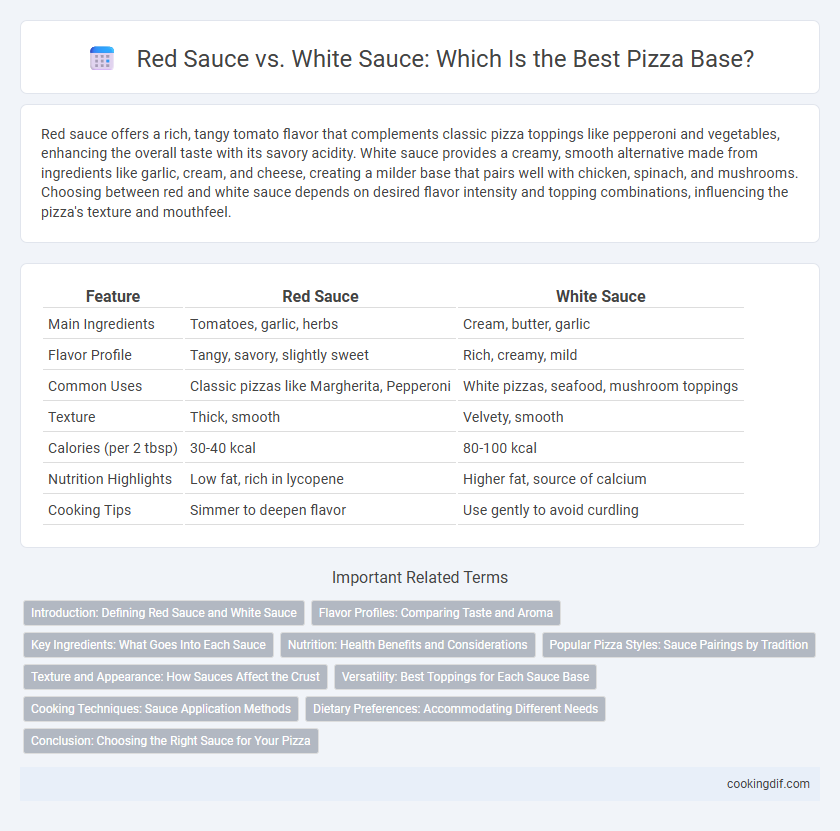Red sauce offers a rich, tangy tomato flavor that complements classic pizza toppings like pepperoni and vegetables, enhancing the overall taste with its savory acidity. White sauce provides a creamy, smooth alternative made from ingredients like garlic, cream, and cheese, creating a milder base that pairs well with chicken, spinach, and mushrooms. Choosing between red and white sauce depends on desired flavor intensity and topping combinations, influencing the pizza's texture and mouthfeel.
Table of Comparison
| Feature | Red Sauce | White Sauce |
|---|---|---|
| Main Ingredients | Tomatoes, garlic, herbs | Cream, butter, garlic |
| Flavor Profile | Tangy, savory, slightly sweet | Rich, creamy, mild |
| Common Uses | Classic pizzas like Margherita, Pepperoni | White pizzas, seafood, mushroom toppings |
| Texture | Thick, smooth | Velvety, smooth |
| Calories (per 2 tbsp) | 30-40 kcal | 80-100 kcal |
| Nutrition Highlights | Low fat, rich in lycopene | Higher fat, source of calcium |
| Cooking Tips | Simmer to deepen flavor | Use gently to avoid curdling |
Introduction: Defining Red Sauce and White Sauce
Red sauce, typically made from crushed tomatoes blended with garlic, herbs, and olive oil, provides a rich, tangy base for traditional pizzas. White sauce, often a creamy mixture of butter, flour, milk, and garlic, creates a smooth, subtle foundation enhancing toppings without overpowering them. Understanding these foundational sauces helps in choosing the perfect flavor profile for various pizza styles.
Flavor Profiles: Comparing Taste and Aroma
Red sauce offers a rich, tangy flavor profile dominated by ripe tomatoes, garlic, and herbs, creating a robust and slightly acidic base that enhances traditional Italian-style pizzas. White sauce, often made from butter, cream, and cheese, provides a creamy, mild, and buttery taste with subtle garlic or nutmeg undertones, lending a smooth and decadent aroma. The choice between red and white sauce significantly influences the pizza's overall flavor intensity, with red sauce delivering a bold zest and white sauce offering a luxurious, mellow richness.
Key Ingredients: What Goes Into Each Sauce
Red sauce for pizza typically contains crushed tomatoes, garlic, olive oil, oregano, and basil, creating a rich and tangy flavor profile essential for classic Italian-style pizzas. White sauce, often made from a creamy base of butter, heavy cream, garlic, and Parmesan cheese, offers a smooth and mild alternative that complements toppings like chicken, mushrooms, or spinach. The choice between red and white sauce significantly impacts the pizza's overall taste, texture, and pairing options, driven by the distinct key ingredients in each base.
Nutrition: Health Benefits and Considerations
Red sauce, typically made from tomatoes, is rich in antioxidants like lycopene, vitamin C, and potassium, which support heart health and immune function. White sauce, often cream-based, contains higher levels of saturated fats and calories, which may impact cholesterol levels if consumed excessively. Choosing red sauce can provide beneficial nutrients for overall health, while white sauce should be enjoyed in moderation to balance calorie intake and fat consumption.
Popular Pizza Styles: Sauce Pairings by Tradition
Red sauce, typically made from tomatoes and herbs, forms the classic base for popular pizza styles such as Neapolitan and New York-style, offering a tangy and robust flavor profile. White sauce, often composed of garlic, cream, and cheese, is favored in styles like White Pizza and some Sicilian variants, providing a rich and creamy complement to toppings like spinach and mushrooms. Traditional sauce pairings highlight regional preferences, with red sauce dominating Southern Italian and American pizzas, while white sauce enjoys popularity in more artisanal and contemporary pizza creations.
Texture and Appearance: How Sauces Affect the Crust
Red sauce, typically tomato-based, adds a vibrant color and moisture that softens the crust's edge, creating a slightly chewy texture. White sauce, often cream or cheese-based, provides a richer, smoother layer that can result in a more tender and less crispy crust. The choice between red and white sauce influences not only the pizza's visual appeal but also the structural integrity and mouthfeel of the crust.
Versatility: Best Toppings for Each Sauce Base
Red sauce, rich in tomatoes and herbs, pairs best with traditional toppings like pepperoni, sausage, mushrooms, and bell peppers, enhancing the sauce's tangy, savory profile. White sauce, often creamy with garlic and cheese, complements chicken, spinach, artichokes, and smoked salmon, offering a smooth, rich base that balances milder or more delicate flavors. Choosing the right sauce base maximizes the flavor synergy with specific toppings, creating a well-rounded and versatile pizza experience.
Cooking Techniques: Sauce Application Methods
Red sauce for pizza base is traditionally spread evenly with the back of a spoon or ladle, ensuring a thin layer that balances moisture and flavor without sogginess. White sauce, often a bechamel or garlic cream, requires gentle warming before application to prevent curdling and is typically applied with a brush or small spoon for precise coverage. Proper sauce application methods impact crust texture and baking time, making technique crucial for optimal pizza quality.
Dietary Preferences: Accommodating Different Needs
Red sauce, typically made from tomatoes, is rich in antioxidants like lycopene and provides a lower-calorie option with natural vitamins, making it suitable for those seeking heart-healthy and vegan choices. White sauce, often cream- or cheese-based, offers a richer, higher-fat alternative preferred by individuals requiring higher caloric intake or a dairy-rich diet. Catering to dietary preferences involves selecting the sauce base that aligns with nutritional needs, whether prioritizing lower sugar content in tomato sauces or seeking calcium and protein from creamy white sauces.
Conclusion: Choosing the Right Sauce for Your Pizza
Red sauce, typically made from tomatoes, offers a tangy, savory base rich in vitamins and antioxidants, enhancing the classic pizza flavor profile. White sauce, often creamy and cheese-based, provides a milder, indulgent taste that complements delicate toppings like chicken or mushrooms. Selecting the right sauce depends on desired flavor intensity and topping compatibility, with red sauce suited for robust ingredients and white sauce ideal for subtle, creamy combinations.
Red sauce vs White sauce for base Infographic

 cookingdif.com
cookingdif.com